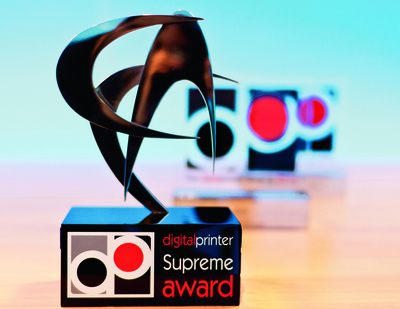London’s Screaming Colour has been producing some stunning work using innovative new technology. In October, it won the Supreme Award at the Digital Printer Awards, after which Andy Knaggs paid the company a visit.
There are few sites in the world of print where you can view a Motioncutter laser cutter on one floor and a Heidelberg platen on the one below. One absolutely certain example though is just along the road from Barbican tube station in London: Screaming Colour.
The juxtaposition of technology – the old and the new – is an interesting one, and fits well with a company that is fast gaining a reputation for outstanding quality married to technological innovation. That reputation received another spike in October, when Screaming Colour won Digital Printer’s Supreme Award at a star-studded ceremony in Mayfair, for a piece (Visions in China) that pushed digital print to its limits, using white ink and metallics.
‘It was beautifully designed by our client and did genuinely demonstrate some of the big advantages of where digital has progressed,’ said managing director Iain Moring modestly. ‘White ink is accessible on digital and it allows you to use some fantastic substrates; it was that combination that made for a beautiful piece in the end.’
Screaming Colour seems to have a singular approach. It is not about technology, although the place is something of a treasure trove in that regard (alongside the HP Indigo presses, Scodix Ultra, Motioncutter, and Zünd table is a 74 Karat DI press); it is more the way of thinking and the way that is backed up organisationally.
Perhaps the most obvious example of this is Screaming Colour’s internal Quality Control team – five individuals whose job is to operate independently of the production team and run a close eye over everything that leaves the factory. Jobs come in from ad agencies and direct relationships with blue chip brands. They are invariably premium pieces that are a highly strategic part of the client’s marketing mix. They are intended to get noticed. This type of work brings pressures of its own, and Screaming Colour’s solution is to get tough with itself.
‘We are control freaks,’ said Mr Moring. ‘That’s the only way, with the deadlines we have, that we can look clients in the eye and give them the commitment that we do. The work is so different and challenging, there’s no opportunity to get it wrong and reprint it. The independent QC team works through the shifts, checking print and finishing quality throughout the process, rather than just spot checks at the end.
‘They look for anything the client won’t be happy with. No-one in the QC team can get involved in production, no matter how busy we are. The difference is that an operator checking his own work is subconsciously expecting it to be good, and looks at it like that. The QC person is the opposite: they think what can I find wrong with this?’
This philosophy is ingrained in the business. Production operators have learned to appreciate how important it is as part of the process. They see the results – the awards, the accolades from clients – and they truly understand the value of it.
Mr Moring said there were three basic tenets to how Screaming Colour operates. ‘We are a curious company; our people are always encouraged to ask, can this be done? What are the options? We love to investigate things, so a lot of what we do makes fresh steps in the snow. We are imaginative, and we don’t often get given a fixed brief, but we also have real deadlines to reach, so we have to have real determination to reach those objectives.’
It makes for a challenging environment to work in, but an enjoyable and interesting one. ‘Our account managers and project managers are not just your ordinary order takers,’ he continued. ‘They are asking what could go wrong, what are the challenges to getting this right, and how can we make sure that it does go right?’
Then there is the technology. Screaming Colour has invested around £2 million just in the last year, and is pondering an investment in the B2 format HP Indigo 10000 press next. What about that Motioncutter though – the only one in the UK?
‘It was a very quick and easy decision to buy it – it took about 10 minutes in the demonstration. It excited us to go to the market and to our clients and show them how we can push the boundaries with more digital effects and substrates. We’re only scratching the surface so far. We’re really excited about what we can do with it next year, and we are already coming up with some fantastic ideas. It fits with digital printing really well. It has been everything we expected and a little bit more.’





